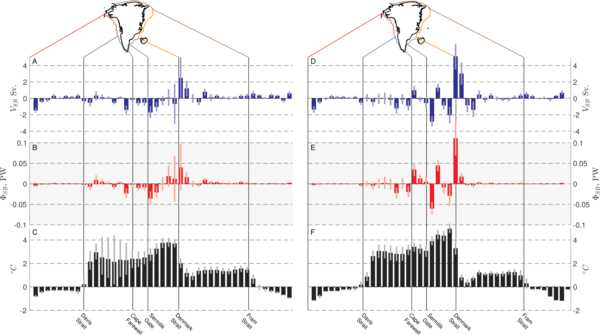Data from: Mechanisms of heat flux across the Southern Greenland continental shelf in 1/10° and 1/12° ocean/sea ice simulations
Data from: Mechanisms of heat flux across the Southern Greenland continental shelf in 1/10° and 1/12° ocean/sea ice simulations
About this collection
- Extent
-
1 digital object.
- Cite This Work
-
Morrison, Theresa J.; Dukhovskoy, Dmitry S.; McClean, Julie L.; Gille, Sarah T.; Chassignet, Eric P. (2023). Data from: Mechanisms of heat flux across the Southern Greenland continental shelf in 1/10° and 1/12° ocean/sea ice simulations. UC San Diego Library Digital Collections. https://doi.org/10.6075/J0319W2S
- Description
-
Volume and heat fluxes across the Greenland continental shelf in two eddy-active coupled ocean/sea-ice simulations. Daily time series of the fluxes are provided at each point along the transect for the period 2005-2009. These data come from coupled ocean/sea-ice simulations that were forced with atmospheric reanalysis fields.
- Date Collected
- 2005 to 2009
- Date Issued
- 2023
- Author
- Principal Investigators
- Researcher
- Funding
-
T.J. Morrison, J.L. McClean and S.T. Gille were funded by DOE Office of Science grants: DE-SC0014440 and DE-SC0020073. D. Dukhovskoy and E. Chassignet were funded by the DOE award DE‐SC0014378 and HYCOM NOPP (award N00014‐15‐1‐2594). The HYCOM‐CICE simulations were supported by a grant of computer time from the DoD High‐Performance Computing Modernization Program at NRL SSC. The POP/CICE simulation was run with a National Center for Atmospheric Research Climate Simulation Laboratory (CSL) allocation on Yellowstone (ark:/85065/d7wd3xhc), sponsored by the National Science Foundation. Some POP/CICE analyses were carried out using Rhea in the Oak Ridge Leadership Computing Facility at the Oak Ridge National Laboratory.
- Geographics
- Topics
Formats
View formats within this collection
- Language
- English
- Identifier
-
Identifier: Dmitry S. Dukhovskoy: https://orcid.org/0000-0002-9114-9796
Identifier: Eric P. Chassignet: https://orcid.org/0000-0003-4710-7502
Identifier: Julie L. McClean: https://orcid.org/0000-0002-8221-2714
Identifier: Sarah T. Gille: https://orcid.org/0000-0001-9144-4368
Identifier: Theresa J. Morrison: https://orcid.org/0000-0001-7734-9444
- Related Resources
- Morrison, T. J., Dukhovskoy, D. S., McClean, J. L., Gille, S. T., & Chassignet, E. P. (2023). Mechanisms of heat flux across the southern Greenland continental shelf in 1/10° and 1/12° ocean/sea ice simulations. Journal of Geophysical Research: Oceans, 128, e2022JC019021. https://doi.org/10.1029/2022JC019021
- Corrected inter-annual forcing (ciaf) version 2.0, NOAA Geophysical Fluid Dynamics Laboratory: https://data1.gfdl.noaa.gov/nomads/forms/core/COREv2/CIAF_v2.html
- Saha, S., et al. 2010. NCEP Climate Forecast System Reanalysis (CFSR) Selected Hourly Time-Series Products, January 1979 to December 2010. Research Data Archive at the National Center for Atmospheric Research, Computational and Information Systems Laboratory. https://doi.org/10.5065/D6513W89
- Bleck, R. (2002). An oceanic general circulation model framed in hybrid isopycnic- Cartesian coordinates. Ocean modelling, 4(1), 55–88. https://doi.org/10.1016/S1463-5003(01)00012-9
- Chassignet, E. P., Hurlburt, H. E., Smedstad, O. M., Halliwell, G. R., Hogan, P. J., Wallcraft, A. J., . . . Bleck, R. (2007). The HYCOM (HYbrid Coordinate Ocean Model) data assimilative system. Journal of Marine Systems, 65(1-4), 60–83. https://doi.org/10.1016/j.jmarsys.2005.09.016
- Chassignet, E. P., Smith, L. T., Halliwell, G. R., & Bleck, R. (2003). North atlantic simulations with the HYbrid Coordinate Ocean Model (HYCOM): Impact of the vertical coordinate choice, reference density, and thermobaricity. Journal of Physical Oceanography, 33, 2504–2526. https://doi.org/10.1175/1520-0485(2003)033<2504:NASWTH>2.0.CO;2
- Dukowicz, J. K., & Smith, R. D. (1994). Implicit free-surface method for the Bryan- Cox-Semtner ocean model. Journal of Geophysical Research: Oceans, 99(C4), 7991–8014. https://doi.org/10.1029/93JC03455
- Hunke, E. C., Lipscomb, W. H., Turner, A. K., Jeffery, N., & Elliott, S. (2010). CICE: the Los Alamos Sea Ice Model Documentation and Software User’s Manual Version 4.1 LA-CC-06-012. T-3 Fluid Dynamics Group, Los Alamos National Laboratory, 675.
- Hurrell, J. W., Holland, M. M., Gent, P. R., Ghan, S., Kay, J. E., Kushner, P. J., et al. (2013). The Community Earth System Model: A framework for collaborative research. Bulletin of the American Meteorological Society, 94(9), 1339–1360. https://doi.org/10.1175/BAMS-D-12-00121.1
- Large, W. G., & Yeager, S. (2009). The global climatology of an interannually vary- ing air–sea flux data set. Climate dynamics, 33(2-3), 341–364. https://doi.org/10.1007/s00382-008-0441-3
- McClean, J. L., Bader, D. C., Maltrud, M. E., Evans, K. J., Taylor, M., Tang, Q., ... Mahajan, S. (2018). High-resolution fully-coupled ACME v0.1 approximate present day transient climate simulations. (Ocean Sciences Meeting 2018, 12-16/February, Portland/OR. Abstract ID: OM44C-2143.) https://agu.confex.com/agu/os18/meetingapp.cgi/Paper/315049
- Saha, S., Moorthi, S., Pan, H.-L., Wu, X., Wang, J., Nadiga, S., . . . others (2010). The NCEP climate forecast system reanalysis. Bulletin of the American Meteorological Society, 91(8), 1015–1058. https://doi.org/10.1175/2010BAMS3001.1
- Saha, S., Moorthi, S., Wu, X., Wang, J., Nadiga, S., Tripp, P., . . . others (2014). The NCEP climate forecast system version 2. Journal of climate, 27(6), 2185– 2208. https://doi.org/10.1175/JCLI-D-12-00823.1
Primary associated publication
Source data
Reference
 Library Digital Collections
Library Digital Collections
